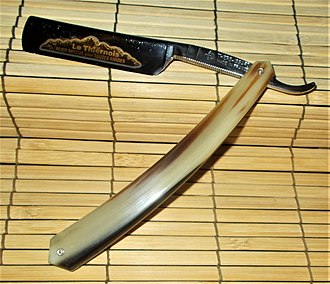
Back شفرة حلاقة مستقيمة Arabic Небяспечная брытва Byelorussian Бръснач Bulgarian Navalla d'afaitar Catalan Břitva Czech Barberkniv Danish Rasiermesser German Tranĉilrazilo Esperanto Navaja de afeitar Spanish Habemenuga Estonian

A straight razor is a razor with a blade that can fold into its handle.[1][2] They are also called open razors and cut-throat razors.[3][4][5] The predecessors of the modern straight razors include bronze razors, with cutting edges and fixed handles, produced by craftsmen from Ancient Egypt during the New Kingdom (1569 — 1081 BC). Solid gold and copper razors were also found in Ancient Egyptian tombs dating back to the 4th millennium BC.
The first steel-edged cutthroat razors were manufactured in Sheffield in 1680. By the late 1680s, early 1690s, razors with silver-covered handles along with other Sheffield-made products known as "Sheffield wares" were being exported to ports in the Gulf of Finland, approximately 1200 miles (1931 km) from Sheffield. From there, these goods were probably sent to Finland and even Russia. By 1740, Benjamin Huntsman was making straight razors complete with decorated handles and hollow-ground blades made from cast steel, using a process he invented. Huntsman's process was adopted by the French sometime later, albeit reluctantly at first due to nationalist considerations. In England, razor manufacturers were even more reluctant than the French to adopt Huntsman's steel-making process and only did so after they saw its success in France.
After their introduction in 1680, straight razors became the principal method of manual shaving for more than two hundred years, and remained in common use until the mid-20th century.[6] Straight razor production eventually fell behind that of the safety razor, which was introduced in the late 19th century and featured a disposable blade. Electric razors have also reduced the market share of the straight razors, especially since the 1950s.[5][6][7] A 1979 comparative study of straight and electric razors, performed by Dutch researchers, found that straight razors shave hair approximately 0.002 in. (0.05mm) shorter than electrics.[8]
Since 2012, production of straight razors has increased multifold. Straight razor sales are increasing globally and manufacturers have difficulty satisfying demand.[9] Sales started increasing since the product was featured in the 2012 James Bond film Skyfall and have remained high since. Straight razors are also perceived as a better value and a more sustainable and efficient product.[9][10] Dovo in Germany reports that since a production low of less than 8,000 units per year in 2006, the company sells 3,000 units per month,[11] and has 110,000 orders with production lead time of three years.[9][11] The increased sales have also led to an increase in the number of associated trades and artisans such as bladesmiths, leather craftsmen, and potters.[9]
Forums and outlets provide products, directions, and advice to straight razor users. Straight razor manufacturers exist in Europe, Asia, and North America. Antique straight razors are also actively traded. Straight razors require considerable skill to hone and strop, and require more care during shaving.[12] Straight razor design and use was once a major portion of the curriculum in barber colleges.[13]
- ^ "Cambridge Dictionary definition". Dictionary.cambridge.org. 2019-05-08. Retrieved 2019-05-14.
- ^ "Merriam Webster definition". Merriam-webster.com. Retrieved 14 May 2019.
- ^ Cite error: The named reference
New Zealandwas invoked but never defined (see the help page). - ^ "Collins Dictionary definition". Dictionary.reverso.net. Retrieved 14 May 2019.
- ^ a b "Dovo Solingen via Web archive". Archived from the original on 2007-02-22. Retrieved 2019-05-14.
- ^ a b ohiokids.org by the Ohio Historical Society, 1982 Velma Ave. Columbus, OH 43211-2497 (through the Internet Archive) quote: "Today, men usually shave with disposable razors or electric razors, but that has not always been the case. For more than two hundred years, most American men who wanted to shave used a straight razor, also known as a straight-edge razor. This type of razor first appeared in England in the 1700s, and remained the mainstay of men's razors until the twentieth century.
- ^ Cite error: The named reference
britannicawas invoked but never defined (see the help page). - ^ Hearst Magazines (February 1983). "Popular Mechanics". Popular Mechanics Magazine. Hearst Magazines: 107. ISSN 0032-4558.
- ^ a b c d Matt Jancer (29 September 2016). "The Straight-Razor Start-Up Package". outsideonline.com.
- ^ "Beard-Loving Hipsters Give Razor Sales a Shave". Time.
The straight razor is also making a comeback, as it's a better value and more efficient, although requires greater care when shaving.
- ^ a b "Traditional straight-razor shaving faces a resurgence". Journal Sentinel.
- ^ "msnbc.msn.com". MSNBC. 2019-05-01. Archived from the original on 2005-02-04. Retrieved 2019-05-14.
- ^ Cite error: The named reference
Thorpe1967was invoked but never defined (see the help page).